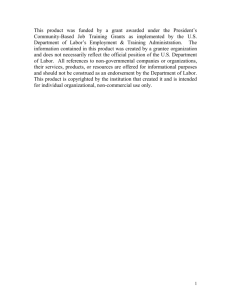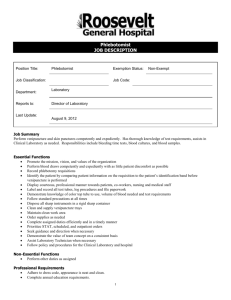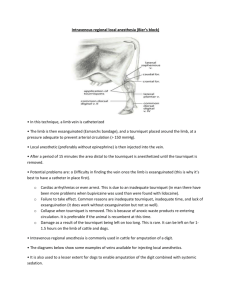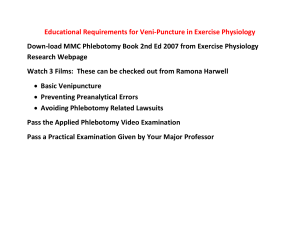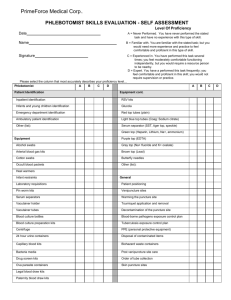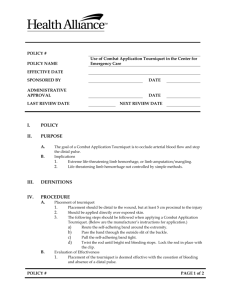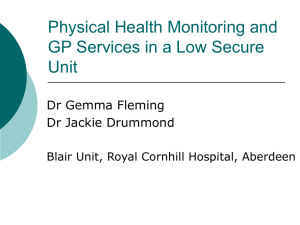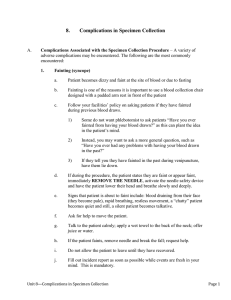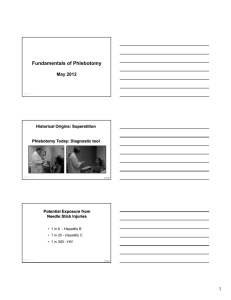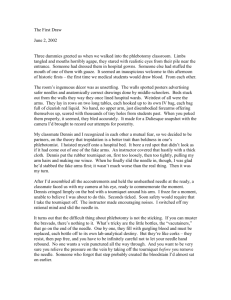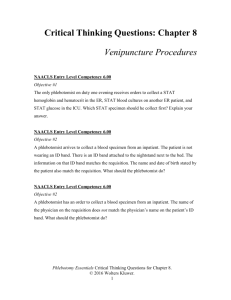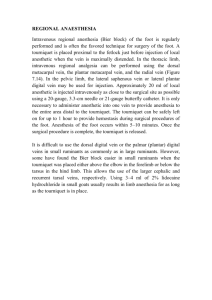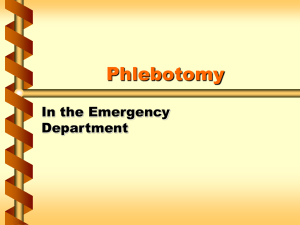Phlebotomy Career Training Test 1 Name: Being a phlebotomist
advertisement
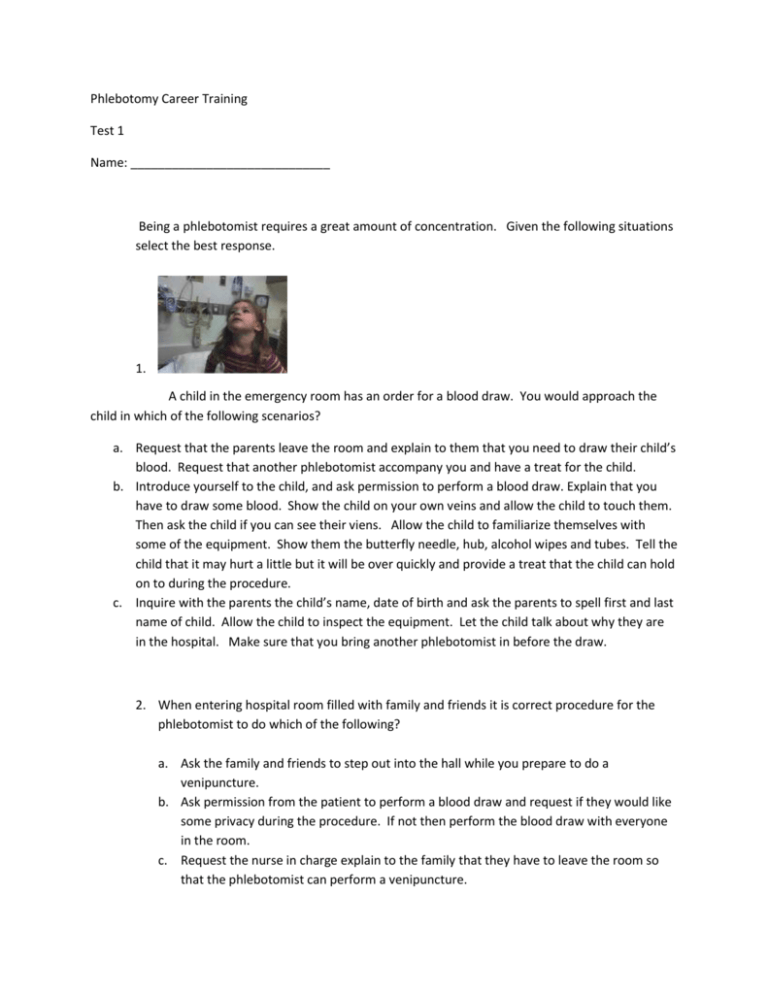
Phlebotomy Career Training Test 1 Name: _____________________________ Being a phlebotomist requires a great amount of concentration. Given the following situations select the best response. 1. A child in the emergency room has an order for a blood draw. You would approach the child in which of the following scenarios? a. Request that the parents leave the room and explain to them that you need to draw their child’s blood. Request that another phlebotomist accompany you and have a treat for the child. b. Introduce yourself to the child, and ask permission to perform a blood draw. Explain that you have to draw some blood. Show the child on your own veins and allow the child to touch them. Then ask the child if you can see their viens. Allow the child to familiarize themselves with some of the equipment. Show them the butterfly needle, hub, alcohol wipes and tubes. Tell the child that it may hurt a little but it will be over quickly and provide a treat that the child can hold on to during the procedure. c. Inquire with the parents the child’s name, date of birth and ask the parents to spell first and last name of child. Allow the child to inspect the equipment. Let the child talk about why they are in the hospital. Make sure that you bring another phlebotomist in before the draw. 2. When entering hospital room filled with family and friends it is correct procedure for the phlebotomist to do which of the following? a. Ask the family and friends to step out into the hall while you prepare to do a venipuncture. b. Ask permission from the patient to perform a blood draw and request if they would like some privacy during the procedure. If not then perform the blood draw with everyone in the room. c. Request the nurse in charge explain to the family that they have to leave the room so that the phlebotomist can perform a venipuncture. 3. Infection control must be observed regularly for the phlebotomist to remain safe from accidental needle sticks. If you have a patient that is prone to seizures it is best to due which of the following. a. Maintain standards precautions as with all patients but keep a particularly close eye on the patient’s facial expressions and behavior to determine if they are going to have a seizure. Allow the patient to lie down if they prefer. b. Wear an extra pair of gloves and have another phlebotomist in the room when you draw to assist in restraining the patient if they go into a seizure. c. Ask a more experienced phlebotomist to draw on a patient prone to seizures. 4. Which of the following scenarios is the best example of therapeutic approach? When approaching a patient who is sitting in a wheelchair scheduled for a blood draw the phlebotomist should… a. Kneel down to their level and introduce themselves. b. Take the patient to their room c. Stand next to the patient and ask them to spell their name. 5. Your patient arrives at their scheduled time for their draw. They tell you that they think that they may have cancer and the lab tests ordered are going to determine if it is so. As a medical professional you would…… a. Begin requesting the patient’s name, date of birth and correct spelling. b. Sit down with the patient and ask them if they would like to talk about their concerns. c. Let the patient know that the doctor will call them with the lab results as soon as possible. 6. It is a busy day at the draw site and the waiting room is full. You are by yourself. The doctor calls and informs you that one of his patients who is scheduled to have their blood drawn needs another test and tells you to go ahead and draw a Lipid Profile. a. Realizing how busy you are, you go ahead and draw the lipid profile for the doctor and explain to the patient that they don’t have to come back for another draw. b. Realize that you are not licensed to take a doctors order, you would explain that the doctor should fax a prescription of the lab test required. c. Write down the order, and draw the lab. 7. You are performing a venipuncture and notice that you have drawn the tubes out of order. Realizing that this patient is a difficult draw you would…. a. Finish your draw and turn in the tubes. b. Remove the needle, discard the tubes and explain to the patient that you have made a mistake in the order of draw. Apologize to them and explain the importance of having the blood drawn in the correct order. Request if they would like another phlebotomist to perform the venipuncture and record your error as well as inform your lab supervisor. c. Apologize to the patient and request permission to perform another venipuncture. 8. You are to perform a draw on a patient who is diabetic. You are in E.R. and notice that their antecubital fossa has not been cleaned………you would… a. Wash the area with warm soap and water prior to sterilizing the site with the patient’s permission. b. Clean the site with betadine and alcohol as per standard procedure c. Request that the patient go to the sink and wash. 9. Your patient states that they are beginning to feel dizzy while you have the needle in their vein. You would. a. Immediately remove the needle and prepare for the patient to faint. b. Finish the draw and bandage the site, them help them to a lying position. c. Finish the draw but only collect one tube instead of 3, and prepare a cot where they can lie down. 10. You have just sustained a needle stick from a patient is positive for HIV. Knowing the standard procedure you would expect …. a. To have follow up blood work immediately b. Receive an immunoglobin injection c. Get counseling d. All of the above 11. Helping someone feel warm by getting them a blanket is fulfilling which of the following? a. Maslows hierarchy of needs b. Cognitive domain c. Therapeutic communication 12. Performing correct medical aseptic technique will help in preventing ….. a. Spread of infection b. Nosocomial infections c. Aleve patients fears d. All of the above 13. When you are explaining the blood drawing procedure you are relying on the patient using their.. a. Cognitive domain b. Affective domain c. Psychomotor domain 14. The smaller the number……… a. The larger the bevel b. The smaller the bevel c. The larger the diameter 15. A tourniquet is the phlebotomists most dangerous piece of equipment for which of the following reasons. a. The tourniquet if left on too long can cause muscle, nerve and tissue damage b. The tourniquet can cause an arm to be amputated in worst case secenario c. The tourniquet can spread infection d. The tourniquet can be incorrectly applied too tight and cause discomfort. e. All of the above 16. For the diagram above indicate the medial cubital vein. 17. What vein is the person pointing too? a. Medial cubital b. Brachial cubital c. Cephalic 18. Refer to the picture above, look at the tourniquet. a. The tourniquet is too tight b. The tourniquet is not straight c. The tourniquet tie is over the antecubital fossa d. All of the above 19. A 18 gauge needle would be the needle of choice for a blood draw. a. True b. False 20. A 27 gauge would be used for a blood draw. a. True b. false
